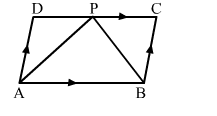In the adjoining figure, ABCD is a parallelogram in which ∠A = 60°. If the bisectors of ∠A and ∠B meet DC at P, prove that (i) ∠APB = 90°, (ii) AD = DP and PB = PC = BC, (iii) DC = 2AD.

ABCD is a parallelogram.
∴ ∠A = ∠C and ∠B = ∠D (Opposite angles)
And ∠A + ∠B = 180o (Adjacent angles are supplementary)
∴ ∠B = 180o − ∠A
⇒ 180o − 60o = 120o ( ∵∠A = 60o)
∴ ∠A = ∠C = 60o and ∠B = ∠D = 120o
(i) $\ln \triangle A P B, \angle P A B=\frac{60^{\circ}}{2}=30^{\circ}$ and $\angle P B A=\frac{120^{\circ}}{2}=60^{\circ}$
$\therefore \angle A P B=180^{\circ}-\left(30^{\circ}+60^{\circ}\right)=90^{\circ}$
(ii) In ∆ ADP, ∠PAD = 30o and ∠ADP = 120o
∴ ∠APB = 180o − (30o + 120o) = 30o
Thus, ∠PAD = ∠APB = 30o
Hence, ∆ADP is an isosceles triangle and AD = DP.
In ∆ PBC, ∠ PBC = 60o, ∠ BPC = 180o − (90o +30o) = 60o and ∠ BCP = 60o (Opposite angle of ∠A)
∴ ∠ PBC = ∠ BPC = ∠ BCP
Hence, ∆PBC is an equilateral triangle and, therefore, PB = PC = BC.
(iii) DC = DP + PC
From (ii), we have:
DC = AD + BC [AD = BC, opposite sides of a parallelogram]
⇒ DC = AD + AD
